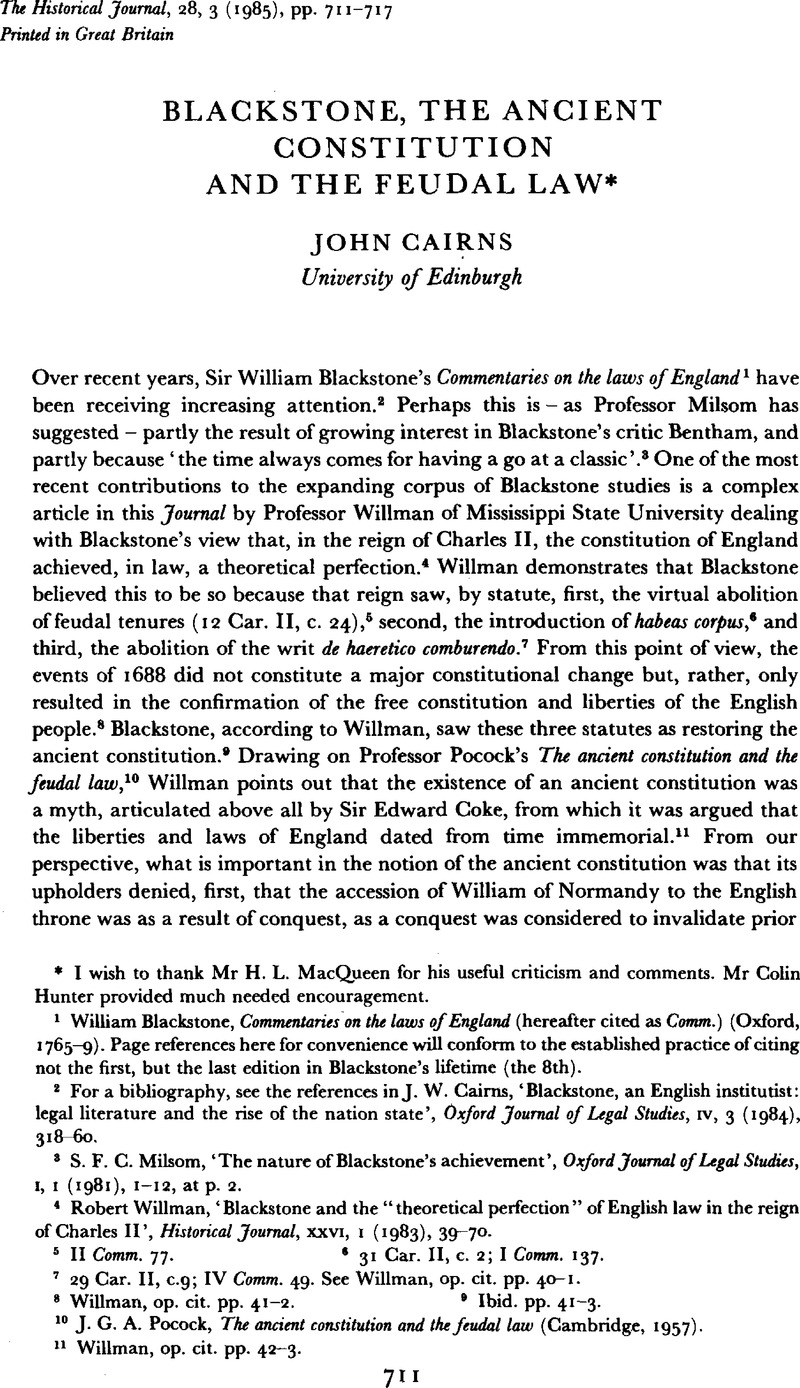Published online by Cambridge University Press: 11 February 2009

1 Blackstone, William, Commentaries on the laws of England (hereafter cited as Comm.) (Oxford, 1765–1769)Google Scholar. Page references here for convenience will conform to the established practice of citing not the first, but the last edition in Blackstone's lifetime (the 8th).
2 For a bibliography, see the references in Cairns, J. W., ‘Blackstone, an English institutist: legal literature and the rise of the nation state’, Oxford Journal of Legal Studies, IV, 3 (1984), 318–60CrossRefGoogle Scholar.
8 Milsom, S. F. C., ‘The nature of Blackstone's achievement’, Oxford Journal of Legal Studies, I, 1 (1981), 1–12, at p. 2Google Scholar.
4 Willman, Robert, ‘Blackstone and the “theoretical perfection” of English law in the reign of Charles II’, Historical Journal, XXVI, I (1983), 39–70CrossRefGoogle Scholar.
5 II Comm. 77.
6 31 Car. II, c. 2; I Comm. 137.
7 29 Car. II, c.9; IV Comm. 49. See Willman, op. cit. pp. 40–1.
8 Willman, op. cit. pp. 41–2.
9 Ibid. pp. 41–3.
10 Pocock, J. G. A., The ancient constitution and the feudal law (Cambridge, 1957)Google Scholar.
11 Willman, op. cit. pp. 42–3.
12 Pocock, op. cit. pp. 42–5.
13 Ibid. pp. 91–228.
14 Willman, op. cit. pp. 43–6.
15 Ibid. pp. 50–62 and 68–72.
16 On this Act see Simpson, A. W. B., Introduction to the history of the land law (Oxford, 1961), pp. 22–3 and 187Google Scholar and Digby, K. E., Introduction to the history of the law of real property (Oxford, 1897), pp. 393–400Google Scholar.
17 Willman, op. cit. pp. 43–6.
18 II Comm. 46–7; IV Comm. 413.
19 IV Comm. 413; II Comm. 48.
20 II Comm. 79–81.
21 II Comm. 85.
22 II Comm. 58, 77–81 and IV Comm. 413, and 417–8; Willman, op. cit. p. 46.
23 II Comm. 45–7.
24 II Comm. 48.
25 II Comm. 48.
26 II Comm. 48. It is interesting to note that in the first edition of the Commentaries Blackstone made no mention of the ‘Norman barons’, so that the passage much more clearly and emphatically stresses that the English consented to the introduction of feudalism.
27 II Comm. 48–9.
28 II Comm. 49.
29 II Comm. 49–50. It is useful to note that in the first edition he is more definite that this was when the feudal polity was introduced, as he states of the events at Sarum, ‘This seems to have been the aera of formally introducing the feodal tenures by law’.
30 II Comm. 50–1.
31 II Comm. 51.
32 II Comm. 51–2.
33 II Comm. 62–3.
34 II Comm. 48–52.
35 II Comm. 77.
36 IV Comm. 412–14.
37 IV Comm. 413.
38 IV Comm. 414–15.
39 IV Comm. 418.
40 II Comm. 78.
41 II Comm. 78.
42 II Comm. 79–81.
43 II Comm. 81.
44 II Comm. 81–5.
45 II Comm. 83.
46 II Comm. 84.
47 II Comm. 84.
48 II Comm. 85.
49 II Comm. 85.
50 II Comm. 86–9.
51 II Comm. 85.
52 II Comm. 85.
53 II Comm. 50.
54 II Comm. 48–52. On knight-service see II Comm. 62–3.
55 As well as the examples already cited, see II Comm. 52, where he states that William the Conqueror and William Rufus ‘kept up with a high hand all the rigours of the feodal doctrines’ which he contrasts with the actions of Henry I, who promised ‘a restitution of the laws of king Edward the confessor, or antient Saxon system’, even if he did not properly carry this out.
56 See Cairns, op. cit. pp. 354–8.
57 In III Comm. 317 law French is described as an ‘evident and shameful badge … of tyranny and foreign servitude’. Cf. IV Comm. 416, 419 and 441.
58 IV Comm. 438.